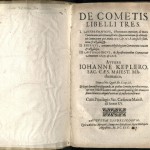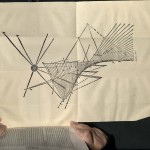Tags
- Kepler, De Cometis…, 1619, Title Page
- Kepler, De Cometis…, 1619
- Kepler, De Cometis…, 1619
De Cometis Libelli Tres
Johannes Kepler (1571-1630)
Avgvst Vindelicorvm: A. Apergeri, 1619
First edition
QB724 K46
Johannes Kepler, a staunch supporter of Galileo, extended the Copernican heliocentric theory of the universe with his three laws of motion, including the revolutionary premise that the planets move not in circular but in elliptical orbits. A mathematician and astronomer, Kepler became Imperial Mathematician to the Emperor Rudolf II of Prague in 1601. After the emperor’s death, Kepler faced religious persecution and for this reason moved often until his death in Regensburg.
De Cometis is divided into three sections. The first and longest contains Kepler’s observations of the comets of 1607 and 1618 and the theories of cometary motion he derived from those observations. The middle section discusses the physical nature of comets. The third section discusses astrological connections with the comets.
As a scientist, Kepler recognized that astrological beliefs were based on superstition, but as a man of his age he nevertheless tended to share those beliefs. This thinking included the belief that comets presaged evil and disaster.
Five fold-out plates illustrate Kepler’s observations.




You must be logged in to post a comment.